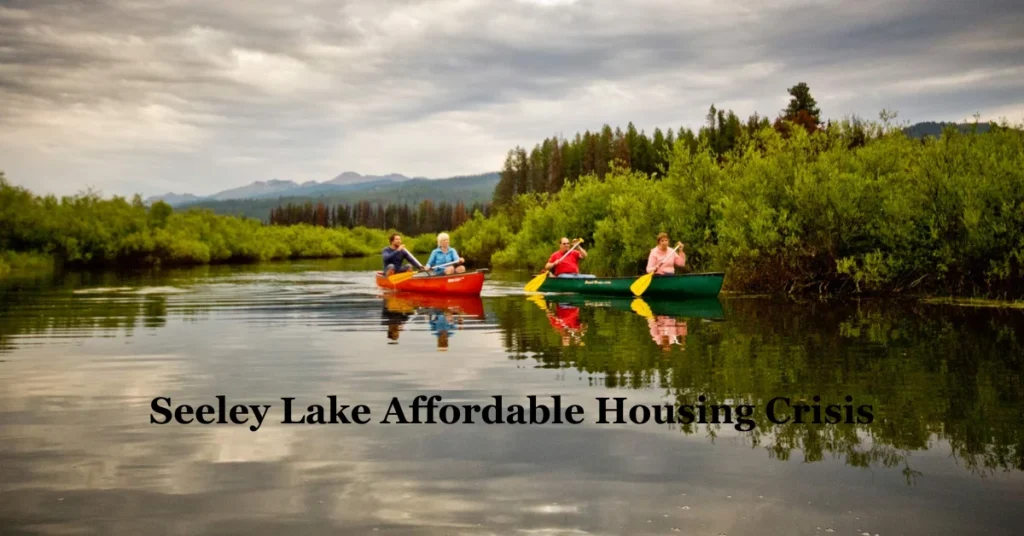Seeley Lake, a small community nestled in Montana’s wilderness, is known for its scenic beauty, outdoor recreation, and tranquil lifestyle. However, like many rural towns across the United States, Seeley Lake faces a growing affordable housing crisis. Rising property prices, limited housing supply, and increased demand have created significant challenges for both long-time residents and newcomers. As the area continues to attract tourists and second-home buyers, many locals find themselves struggling to afford housing in their own community.
In this article, we’ll explore the key causes behind Seeley Lake’s affordable housing crisis and potential solutions that can help the town address this growing issue.
Causes of Seeley Lake’s Affordable Housing Crisis
The affordable housing crisis in Seeley Lake is driven by a complex mix of economic, social, and demographic factors. Here are the main causes contributing to the problem:
1. Rising Property Prices
One of the biggest challenges for Seeley Lake is the sharp rise in property prices over the past decade. As the town gains popularity as a tourist destination and a peaceful getaway for retirees, demand for homes has increased significantly. This influx of interest has driven up property values, making it difficult for local residents, especially lower-income families, to purchase homes.
Second-home buyers and investors from out of state often outbid locals, which further escalates the housing market. These new buyers typically use homes seasonally, leaving many properties vacant for large portions of the year while contributing little to the local housing supply.
2. Limited Housing Supply
Seeley Lake’s housing market is limited by both geography and development constraints. The town is surrounded by national forests and protected lands, limiting the space available for new construction. Additionally, local zoning laws and regulations can make it challenging for developers to build affordable housing or increase housing density.
As a result, the available housing stock remains low, and new construction tends to focus on high-end homes rather than affordable options. This lack of new, affordable housing exacerbates the crisis, leaving low- and middle-income residents with fewer options.
3. Income Disparities and Seasonal Employment
Seeley Lake’s local economy is largely driven by tourism, outdoor recreation, and small businesses. Many jobs in these sectors are seasonal or part-time, and they often do not pay wages high enough to support the cost of living in the area. The gap between the average income of local residents and the rising cost of housing continues to widen, making homeownership or even rental housing unaffordable for many.
Furthermore, many young people and families are finding it increasingly difficult to stay in the area due to the lack of well-paying, year-round employment. This leads to a dwindling population of long-term residents, further weakening the community’s ability to address its housing challenges.
4. Lack of Rental Properties
Another issue compounding the affordable housing crisis in Seeley Lake is the scarcity of rental properties. Much of the housing in the area is designed for ownership rather than rental. With limited long-term rental options available, those who cannot afford to buy a home are left with few choices.
Additionally, some rental properties are increasingly being converted into short-term vacation rentals to cater to tourists. While this can be profitable for property owners, it reduces the number of long-term rental units available for local workers and families.
5. Impact of Remote Work and Migration Trends
The COVID-19 pandemic accelerated migration trends, with many individuals and families moving away from urban centers in search of quieter, more remote locations like Seeley Lake. The rise of remote work allowed more people to live in rural areas while maintaining high-paying jobs in larger cities. This trend has significantly impacted the local housing market, as wealthier remote workers often have the means to purchase properties at higher prices, driving up competition and reducing affordability for long-term residents.
Potential Solutions to Seeley Lake’s Housing Crisis
While the causes of Seeley Lake’s affordable housing crisis are multifaceted, there are several potential solutions that can help alleviate the issue. Here are some approaches that could improve housing accessibility in the community:
1. Encourage Affordable Housing Development
One of the most important steps in addressing Seeley Lake’s housing crisis is to increase the availability of affordable housing. This can be achieved by incentivizing developers to build homes that are accessible to low- and middle-income families. Local governments can offer tax breaks, subsidies, or streamlined approval processes to encourage the construction of affordable units.
In addition, updating zoning regulations to allow for higher-density housing, such as duplexes or townhomes, can help make better use of available land. By diversifying the housing stock, Seeley Lake can provide more options for residents at different income levels.
2. Preserve Existing Affordable Housing
Preserving existing affordable housing is just as important as building new homes. Local leaders can work with property owners to prevent the conversion of long-term rental properties into short-term vacation rentals, which reduces the availability of housing for local residents. This can be done through regulations or incentives that encourage property owners to keep their homes in the long-term rental market.
Additionally, community land trusts or non-profit housing organizations can play a role in acquiring properties and maintaining them as affordable housing units for local families. These initiatives help protect homes from speculative buyers and ensure they remain within reach for those who live and work in Seeley Lake.
3. Expand Workforce Housing Options
Given that much of Seeley Lake’s workforce is employed in tourism and other seasonal industries, developing workforce housing is crucial. Workforce housing refers to housing that is specifically designed for employees in the community, often at rents below market rates.
Collaborating with local businesses and employers can help create affordable housing options for seasonal workers. Employers can invest in housing projects or partner with developers to ensure their workers have access to affordable, stable housing near their places of employment.
4. Support Rent Assistance Programs
For those struggling to afford rent, rent assistance programs can provide a temporary solution. Local governments and non-profits can work together to offer rental subsidies to low-income households, helping them bridge the gap between their income and housing costs. These programs can be especially valuable for families on the brink of homelessness or displacement due to rising rent prices.
By expanding rent assistance programs and providing direct financial support to renters, Seeley Lake can help more residents stay in their homes while longer-term housing solutions are developed.
5. Advocate for State and Federal Support
Addressing the affordable housing crisis requires support beyond the local level. Seeley Lake’s community leaders can advocate for state and federal assistance in the form of grants, loans, or tax incentives that encourage the development of affordable housing. These programs can provide the necessary funding and resources to build new homes, preserve existing units, and support low-income renters.
State and federal policies aimed at addressing housing shortages, such as tax credits for affordable housing developers or subsidies for renters, can provide additional relief for communities like Seeley Lake that are struggling with housing affordability.
6. Promote Sustainable Tourism Development
Since tourism plays a significant role in Seeley Lake’s economy, promoting sustainable tourism development is essential to balancing the needs of both visitors and residents. Tourism can be a double-edged sword, driving economic growth while also putting pressure on housing and infrastructure.
Local governments and business owners can work together to implement policies that support sustainable tourism, such as regulating short-term rentals, encouraging eco-friendly practices, and investing in infrastructure that benefits both tourists and the local population. By managing the growth of tourism in a way that preserves the community’s housing stock, Seeley Lake can maintain its appeal as a destination without displacing its residents.
Conclusion
Seeley Lake’s affordable housing crisis is a growing problem that requires a multifaceted approach. Rising property prices, limited housing supply, and income disparities have left many residents struggling to find affordable housing. However, by encouraging affordable housing development, preserving existing units, expanding workforce housing, and advocating for state and federal support, Seeley Lake can begin to address these challenges.
Community engagement and thoughtful planning are key to ensuring that Seeley Lake remains a vibrant and accessible place for both current residents and future generations.
FAQS
1. Why is Seeley Lake experiencing an affordable housing crisis?
Seeley Lake is facing an affordable housing crisis due to rising property prices, limited housing supply, income disparities, and increased demand from tourists and second-home buyers.
2. How are seasonal jobs affecting the housing market in Seeley Lake?
Many jobs in Seeley Lake are seasonal or part-time, which makes it difficult for workers to afford rising housing costs. The lack of stable, year-round employment contributes to the affordability gap for local residents.
3. What role do short-term rentals play in the housing crisis?
Short-term rentals reduce the availability of long-term rental properties, driving up prices and limiting housing options for local residents. This trend is especially problematic in tourist destinations like Seeley Lake.
4. What solutions are being considered to address the housing shortage?
Solutions include encouraging affordable housing development, preserving existing affordable units, expanding workforce housing, providing rent assistance, and advocating for state and federal support.







